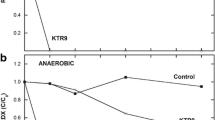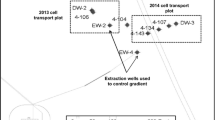Abstract
The potential for bioaugmentation with aerobic explosive degrading bacteria to remediate hexahydro-1,3,5-trinitro-1,3,5-triazine (RDX) contaminated aquifers was demonstrated. Repacked aquifer sediment columns were used to examine the transport and RDX degradation capacity of the known RDX degrading bacterial strains Gordonia sp. KTR9 (modified with a kanamycin resistance gene) Pseudomonas fluorescens I-C, and a kanamycin resistant transconjugate Rhodococcus jostii RHA1 pGKT2:Km+. All three strains were transported through the columns and eluted ahead of the conservative bromide tracer, although the total breakthrough varied by strain. The introduced cells responded to biostimulation with fructose (18 mg L−1, 0.1 mM) by degrading dissolved RDX (0.5 mg L−1, 2.3 µM). The strains retained RDX-degrading activity for at least 6 months following periods of starvation when no fructose was supplied to the column. Post-experiment analysis of the soil indicated that the residual cells were distributed along the length of the column. When the strains were grown to densities relevant for field-scale application, the cells remained viable and able to degrade RDX for at least 3 months when stored at 4 °C. These results indicate that bioaugmentation may be a viable option for treating RDX in large dilute aerobic plumes.
Graphical Abstract







Similar content being viewed by others
References
Adrian N, Sutherland K (1999) RDX biodegradation by a methanogenic enrichment culture obtained from an explosives manufacturing wastewater treatment plant. U.S. Army Corps of Engineers, Construction Engineering Research Laboratories. Report# 99/15
Arnett CM, Adrian NR (2009) Cosubstrate independent mineralization of hexahydro-1,3,5-trinitro-1,3,5-triazine (RDX) by a Desulfovibrio species under anaerobic conditions. Biodegradation 20:15–26
Bernstein A, Adar E, Nejidat A, Ronen Z (2011) Isolation and characterization of RDX-degrading Rhodococcus species from a contaminated aquifer. Biodegradation 22:997–1005
Brannon J, Myers T (1997) Review of fate and transport process of explosives. Army Corps of Engineers, Waterways Experiment Station. Report# IRRP-97-2
Clausen J, Robb J, Curry D, Korte N (2004) A case study of contamination on military ranges: Camp Edwards, Massachusetts, USA. Environ Pollut 129:13–21
DeFlaun M, Tanzer A, McAteer A, Marshall B, Levy S (1990) Development of an adhesion assay and characterization of an adhesion-deficient mutant of Pseudomonas fluorescens. Appl Environ Microbiol 56:112–119
Dong H, Rothmel RK, Onstott TC, Fuller ME, DeFlaun MF, Dunlap R, Fletcher M (2002) Simultaneous transport of two bacterial strains in intact cores from Oyster, Virginia: biological effects and numerical modeling. Appl Environ Microbiol 68:2120–2132
Fournier D, Halasz A, Spain J, Fiurasek P, Hawari J (2002) Determination of key metabolites during biodegradation of hexahydro-1,3,5-trinitro-1,3,5-triazine with Rhodococcus sp. strain DN22. Appl Environ Microbiol 68:166–172
Fuller ME, Dong H, Mailloux BJ, Onstott TC, DeFlaun MF (2000) Examining bacterial transport in intact cores from Oyster, Virginia: effect of sedimentary facies type on bacterial breakthrough and retention. Water Resour Res 36:2417–2431
Fuller ME, McClay K, Hawari J, Paquet L, Malone TE, Fox BG, Steffan RJ (2009) Transformation of RDX and other energetic compounds by xenobiotic reductases XenA and XenB. Appl Microbiol Biotechnol 84:535–544
Fuller ME, Hawari J, Perreault N (2010a) Microaerophilic degradation of hexahydro-1,3,5-trinitro-1,3,5-triazine (RDX) by three Rhodococcus strains. Lett Appl Microbiol 51:313–318
Fuller ME, McClay K, Higham M, Hatzinger PB, Steffan RJ (2010b) Hexahydro-1,3,5-trinitro-1,3,5-triazine (RDX) bioremediation in groundwater: are known RDX-degrading bacteria the dominant players? Bioremediat J 14:121–134
Ginn TR (2002) A travel time approach to exclusion on transport in porous media. Water Resour Res 38:12-1–12-11. doi:10.1029/2001WR000865
Hareland WA, Crawford RL, Chapman PJ, Dagley S (1975) Metabolic function and properties of 4-hydroxyphenylacetic acid 1-hydroxylase from Pseudomonas acidovorans. J Bacteriol 121:272–285
Hatzinger PB, Lippincott D (2012) In situ bioremediation of energetic compounds in groundwater. Environmental Security Technology Certification Program (ESTCP). Report# ER-200425
Hawari J, Halasz A, Beaudet S, Paquet L, Ampleman G, Thiboutot S (2001) Biotransformation routes of octahydro-1,3,5,7-tetranitro-1,3,5,7-tetrazocine by municipal anaerobic sludge. Environ Sci Technol 35:70–75
Indest KJ, Jung CM, Chen H-P, Hancock D, Florizone C, Eltis LD, Crocker FH (2010) Functional characterization of pGKT2, a 182-kilobase plasmid containing the xplAB genes, which are involved in the degradation of hexahydro-1,3,5-trinitro-1,3,5-triazine by Gordonia sp. strain KTR9. Appl Environ Microbiol 76:6329–6337. doi:10.1128/aem.01217-10
Indest KJ, Hancock DE, Jung CM, Eberly JO, Mohn WW, Eltis LD, Crocker FH (2013) Role of nitrogen limitation in transformation of RDX (hexahydro-1,3,5-trinitro-1,3,5-triazine) by Gordonia sp. strain KTR9. Appl Environ Microbiol 79:1746–1750. doi:10.1128/aem.03905-12
Jung CM, Crocker FH, Eberly JO, Indest KJ (2011) Horizontal gene transfer (HGT) as a mechanism of disseminating RDX-degrading activity among Actinomycete bacteria. J Appl Microbiol 110:1449–1459
Li Q, Logan BE (1999) Enhancing bacterial transport for bioaugmentation of aquifers using low ionic strength solutions and surfactants. Water Res 33:1090–1100. doi:10.1016/S0043-1354(98)00291-7
Michalsen MM, Weiss R, King A, Gent D, Medina VF, Istok JD (2013) Push–pull tests for estimating RDX and TNT degradation rates in groundwater. Groundw Monit Remediat 33:61–68. doi:10.1111/gwmr.12016
Newell C (2008) Treatment of RDX & HMX plumes using mulch biowalls. Environmental Security Technology Certification Program (ESTCP). Report# ER-0426
Pennington JC et al (2001) Distribution and fate of energetics on DoD test and training ranges: Interim Report 1. U.S. Army Engineer Research and Development Center. Report# ERDC TR-01-13
Pennington JC et al (2002) Distribution and fate of energetics on DoD test and training ranges: Interim Report 2. U.S. Army Engineer Research and Development Center. Report# ERDC TR-02-8
Priestley JT, Coleman NV, Duxbury T (2006) Growth rate and nutrient limitation affect the transport of Rhodococcus sp. strain DN22 through sand. Biodegradation 17:571–576
Ronen Z, Yanovich Y, Goldin R, Adar E (2008) Metabolism of the explosive hexahydro-1,3,5-trinitro-1,3,5-triazine (RDX) in a contaminated vadose zone. Chemosphere 73:1492–1498
Schaefer CE, Fuller ME, Condee CW, Lowey JM, Hatzinger PB (2007) Comparison of biotic and abiotic treatment approaches for co-mingled perchlorate, nitrate, and nitramine explosives in groundwater. J Contam Hydrol 89:231–250
Seth-Smith HMB, Rosser SJ, Basran A, Travis ER, Dabbs ER, Nicklin S, Bruce NC (2002) Cloning, sequencing, and characterization of the hexahydro-1,3,5-trinitro-1,3,5-triazine degradation gene cluster from Rhodococcus rhodochrous. Appl Environ Microbiol 68:4764–4771
Seth-Smith HMB, Edwards J, Rosser SJ, Rathbone DA, Bruce NC (2008) The explosive-degrading cytochrome P450 system is highly conserved among strains of Rhodococcus spp. Appl Environ Microbiol 74:4550–4552. doi:10.1128/aem.00391-08
Shaw JC, Bramhill B, Wardlaw NC, Costerton JW (1985) Bacterial fouling in a model core system. Appl Environ Microbiol 49:693–701
Steffan RJ, Vainberg S (2013) Production and handling of Dehalococcoides bioaugmentation cultures. In: Stroo HF, Leeson A, Ward CH (eds) Bioaugmentation for groundwater remediation. SERDP ESTCP Environmental Remediation Technology. Springer, New York, pp 89–115. doi:10.1007/978-1-4614-4115-1_3
Streger SH, Vainberg S, Dong H, Hatzinger PB (2002) Enhancing transport of Hydrogenophaga flava ENV735 for bioaugmentation of aquifers contaminated with methyl tert-butyl ether. Appl Environ Microbiol 68:5571–5579. doi:10.1128/aem.68.11.5571-5579.2002
Stumpp C, Lawrence JR, Hendry MJ, Maloszewski P (2011) Transport and bacterial interactions of three bacterial strains in saturated column experiments. Environ Sci Technol 45:2116–2123. doi:10.1021/es103569u
Thompson KT, Crocker FH, Fredrickson HL (2005) Mineralization of the cyclic nitramine explosive hexahydro-1,3,5-trinitro-1,3,5-triazine by Gordonia and Williamsia spp. Appl Environ Microbiol 71:8265–8272
Toride N, Leij FJ, van Genuchten MT (1995) The CXTFIT code for estimating transport parameters from laboratory or field tracer experiments, Version 2.0. U.S. Salinity Laboratory, USDA, ARS, Riverside
Vainberg S, Condee CW, Steffan RJ (2009) Large-scale production of bacterial consortia for remediation of chlorinated solvent-contaminated groundwater. J Ind Microbiol Biotechnol 36:1189–1197. doi:10.1007/s10295-009-0600-5
Wade R, Davis JL, Wani AH, Felt D (2010) Biologically active zone enhancement (BAZE) for in situ RDX degradation in ground water. Environmental Security Technology Certification Program (ESTCP). Report# ER-0110
Yamamoto H, Morley MC, Speitel GE Jr, Clausen J (2004) Fate and transport of high explosives in a sandy soil: adsorption and desorption. Soil Sediment Contam 13:459–477
Zhang C, Hughes JB (2003) Biodegradation pathways of hexahydro-1,3,5-trinitro-1,3,5-triazine (RDX) by Clostridium acetobutylicum cell-free extract. Chemosphere 50:665–671
Zhao J-S, Paquet L, Halasz A, Manno D, Hawari J (2004) Metabolism of octahydro-1,3,5,7-tetranitro-1,3,5,7-tetrazocine by Clostridium bifermentans strain HAW-1 and several other H2-producing fermentative anaerobic bacteria. FEMS Microbiol Lett 237:65–72
Acknowledgments
This project was supported by the Environmental Security Technology Certification Program (ESTCP) under contract W912DW-12-C-0029. Views, opinions, and/or findings contained in this report are those of the author(s) and should not be construed as an official Department of Defense position or decision unless so designated by other official documentation.
Author information
Authors and Affiliations
Corresponding author
Electronic supplementary material
Below is the link to the electronic supplementary material.
Rights and permissions
About this article
Cite this article
Fuller, M.E., Hatzinger, P.B., Condee, C.W. et al. Laboratory evaluation of bioaugmentation for aerobic treatment of RDX in groundwater. Biodegradation 26, 77–89 (2015). https://doi.org/10.1007/s10532-014-9717-y
Received:
Accepted:
Published:
Issue Date:
DOI: https://doi.org/10.1007/s10532-014-9717-y




